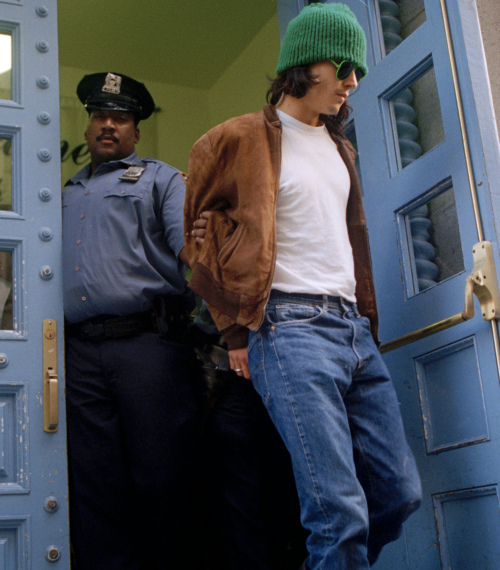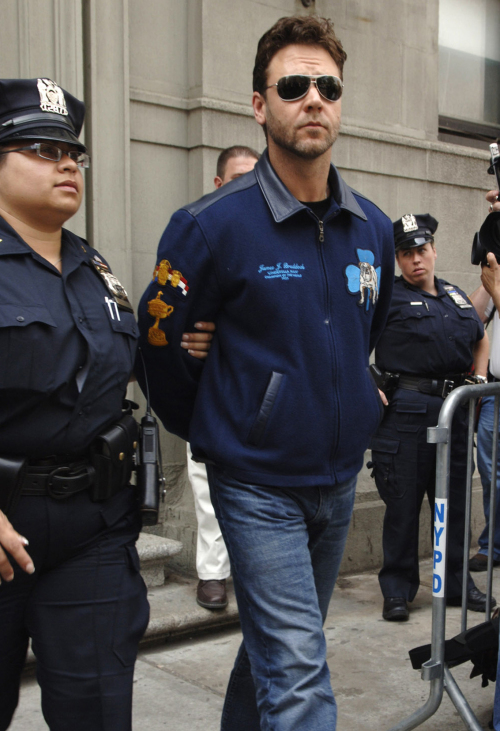NEW YORK (AP) ― A sea of cameras captured a rumpled, handcuffed, angry-looking Dominique Strauss-Kahn as plainclothes detectives took the International Monetary Fund head from a police precinct to court. The images weren’t unusual for a high-profile criminal case in the U.S., but in his French homeland, they’d be illegal.
While American authorities have condoned such “perp walks” (short for perpetrator) for more than a century, in France it’s been illegal to show images of suspects in handcuffs since 2000. French politicians and citizens alike are upset by the images, which they say make Strauss-Kahn, accused of sexual abuse, appear guilty.
“DSK Handcuffed: Photo Shock,” read a headline in Tuesday’s daily Le Parisien.
“Dominique still is presumed innocent,” said Martine Aubry, head of France’s Socialist party, which had been expected to make Strauss-Kahn its nominee to challenge President Nicolas Sarkozy in next year’s election.
Sylfie Vallon el Kadri, a French civil servant, said the images of Strauss-Kahn in court “were difficult to bear.”
“It was very humiliating for him whatever the results of the investigation are,” she said. “Whether he is guilty or not, his image is certainly tarnished. His political career has just stopped abruptly.”
In the United States, and especially in New York, criminal suspects are literally walked out of police precincts with officers to face charges in court.
Celebrities including Johnny Depp and Russell Crowe, professional athletes, politicians and average citizens arrested for headline-grabbing crimes in New York have all received such treatment. In Dallas, Lee Harvey Oswald was being walked after killing President John F. Kennedy when he was fatally shot in 1963, the iconic image captured by hungry photographers.
 |
Actor Johnny Depp is escorted out of the 19th Precinct in New York following his arrest. (AP-Yonhap News) |
 |
Actor Russell Crowe is taken in handcuffs from a lower Manhattan police precinct, in New York. (AP-Yonhap News) |
“I think it is humiliating,” New York Mayor Bloomberg said of the practice. “But, you know, if you don’t want do the perp walk, don’t do the crime.”
Bloomberg quickly corrected himself, noting that suspects are innocent until proven guilty.
Strauss-Kahn made his perp walk in the early-morning hours Sunday as he left a Harlem precinct to face charges of attempted rape and sexual abuse in a suspected attack on a hotel maid. Photographers waited hours outside the station house for him to emerge. Later, photos captured a scruffy Strauss-Kahn inside a Manhattan courtroom.
The New York Police Department doesn’t make a practice of letting reporters know when a suspect is going to leave a precinct, but they also don’t go to special lengths to sneak someone out when cameras are waiting outside. The department does not release mug shots.
“These aren’t scheduled events,” said chief spokesman Paul Browne.
Whether quietly tipped off by police eager to show off good detective work, or just employing savvy beat reporters, the media somehow always seem to know where the suspect is going to be, and there’s no law prohibiting the practice.
“The media is relentless. They’ll follow police cars, and hang out of trees. They do whatever they have to do to get a picture,” said Al Primo, a TV consultant who came up with the ABC “Eyewitness News” idea.
A lawsuit in the late 1990s challenged what was known as the “staged” walk, where police sometimes paraded the suspect outside for no other reason than so media could take pictures. A judge ruled that staged walks violated the suspect’s constitutional rights, but in 2003 a U.S. appeals court found that non-staged perp walks were constitutional.
Defense attorneys say the images can be hard to counter, and can sometimes poison a jury pool, but they generally tolerate the practice as a necessary evil.
Philip J. Dinhofer, the lawyer who argued the case against staged walks, said non-staged walks can provide a public service by showing the public who was caught so other potential victims can come forward. He said they also can help calm the public after arrests are made for high-profile violent crimes.
He questioned whether the public treatment Strauss-Kahn faces is any different from the embarrassment former California Gov. Arnold Schwarzenegger is going through after his public admission that he fathered a child with another woman.
“The public exacts a high price from its political leaders to be beyond reproach on public and ethical grounds,” he said. “Sometimes you stick your neck out into the public realm and it gets cut off.”
The practice varies around the world ― in Japan, for instance, police generally cover suspects’ faces with jackets or scarves whenever they might be caught on film.
Some other countries, however, make the U.S. approach look tame.
In Mexico, suspects are paraded in front of cameras handcuffed, bruised and often bloodied. Several countries in Southeast Asia parade suspects accused of drug crimes in front of journalists at news conferences and pile any seized contraband on a table in front of the accused.
For violent crimes, Thailand goes a step further, forcing some suspects whom police say have confessed to re-enact their alleged crimes in front of journalists and family members of victims. The stagings can be gruesome ― one included the corpse of a murdered child ― and they have occasionally incited lynch mobs.
Not every prominent U.S. suspect gets a perp walk, though the reasons some authorities avoid them aren’t necessarily related to the rights of the accused. In Los Angeles, for instance, it’s common for celebrities to be shuttled to and from court using hidden routes, in large part because the media crush can be so overwhelming that police consider a perp walk to be a potential safety hazard.
Even so, photographers in Southern California have often been able to get shots of big-name suspects such as O.J. Simpson and Michael Jackson in handcuffs. Dr. Conrad Murray, who is accused of manslaughter in Jackson’s death, managed to avoid handcuffs when he was arrested last year after his attorneys argued with authorities over the terms of his surrender.
In New York, law enforcement would likely have been accused of giving the French suspect special treatment had he been spirited away secretly. Rocker David Lee Roth, rapper Tupac Shakur and civil rights leader Al Sharpton were all walked in front of cameras, as were several mafia dons.
According to police historian Thomas Reppetto, in 1903, the NYPD once paraded a bunch of arrested Mafia suspects through the streets of Little Italy.
The department said it was because it couldn’t get the horse-drawn wagons to come. But really police wanted to show the mob they were in charge ― and they made the press happy, too, Reppetto said.
“An arrest is a public event,” he said.





![[Herald Interview] 'Trump will use tariffs as first line of defense for American manufacturing'](http://res.heraldm.com/phpwas/restmb_idxmake.php?idx=644&simg=/content/image/2024/11/26/20241126050017_0.jpg)

![[Health and care] Getting cancer young: Why cancer isn’t just an older person’s battle](http://res.heraldm.com/phpwas/restmb_idxmake.php?idx=644&simg=/content/image/2024/11/26/20241126050043_0.jpg)

